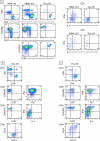Topical TLR7 agonist imiquimod can induce immune-mediated rejection of skin metastases in patients with breast cancer
- PMID: 22767669
- PMCID: PMC3580198
- DOI: 10.1158/1078-0432.CCR-12-1149
Topical TLR7 agonist imiquimod can induce immune-mediated rejection of skin metastases in patients with breast cancer
Abstract
Purpose: Skin metastases of breast cancer remain a therapeutic challenge. Toll-like receptor 7 agonist imiquimod is an immune response modifier and can induce immune-mediated rejection of primary skin malignancies when topically applied. Here we tested the hypothesis that topical imiquimod stimulates local antitumor immunity and induces the regression of breast cancer skin metastases.
Experimental design: A prospective clinical trial was designed to evaluate the local tumor response rate of breast cancer skin metastases treated with topical imiquimod, applied 5 d/wk for 8 weeks. Safety and immunologic correlates were secondary objectives.
Results: Ten patients were enrolled and completed the study. Imiquimod treatment was well tolerated, with only grade 1 to 2 transient local and systemic side effects consistent with imiquimod's immunomodulatory effects. Two patients achieved a partial response [20%; 95% confidence interval (CI), 3%-56%]. Responders showed histologic tumor regression with evidence of an immune-mediated response, showed by changes in the tumor lymphocytic infiltrate and locally produced cytokines.
Conclusion: Topical imiquimod is a beneficial treatment modality for breast cancer metastatic to skin/chest wall and is well tolerated. Importantly, imiquimod can promote a proimmunogenic tumor microenvironment in breast cancer. Preclinical data generated by our group suggest superior results with a combination of imiquimod and ionizing radiation and we are currently testing in patients whether the combination can further improve antitumor immune and clinical responses.
©2012 AACR.
Figures



Comment in
-
Breast cancer treatment with imiquimod: applying an old lotion to a new disease.Clin Cancer Res. 2012 Dec 15;18(24):6571-3. doi: 10.1158/1078-0432.CCR-12-3138. Epub 2012 Nov 21. Clin Cancer Res. 2012. PMID: 23172886
References
-
- Krathen RA, Orengo IF, Rosen T. Cutaneous metastasis: a meta-analysis of data. South Med J. 2003;96:164–167. - PubMed
-
- Lookingbill DP, Spangler N, Helm KF. Cutaneous metastases in patients with metastatic carcinoma: a retrospective study of 4020 patients. J Am Acad Dermatol. 1993;29:228–236. - PubMed
-
- Hemmi H, Kaisho T, Takeuchi O, Sato S, Sanjo H, Hoshino K, et al. Small anti-viral compounds activate immune cells via the TLR7 MyD88-dependent signaling pathway. Nat. Immunol. 2002;3:196–200. - PubMed
-
- Takeda K, Akira S. TLR signaling pathways. Semin Immunol. 2004;16:3–9. - PubMed
-
- Cheever MA. Twelve immunotherapy drugs that could cure cancers. Immunol Rev. 2008;222:357–368. - PubMed
Publication types
MeSH terms
Substances
Grants and funding
LinkOut - more resources
Full Text Sources
Other Literature Sources
Medical

